Below are the most common reasons women seek breast implant revision and replacement. Click on a link to see details about treatment for a particular reason for breast implant revision:
- Desire for size change, either larger or smaller
- Correction of capsular contracture
- Treatment of implant rippling and palpability
- Correction of implant deflation or leakage
- Treatment of a “double bubble” deformity (inframammary fold asymmetry)
- Correction of implant malposition
- Prior breast augmentation with French PIP breast implants
- Request to remove breast implants
Desire for size change, either larger or smaller
Following breast augmentation, patients will sometimes decide to change their implants to a larger or smaller size. We have reduced the incidence of this with our own patients at the Parker Center, by using our sizing and shaping program. When patients do decide to undergo a size change, Dr. Parker can normally use the prior incision for implant removal and replacement.
In patients desiring larger implants, Dr. Parker surgically enlarges the “pocket,” or space in the breast to accommodate the larger implant, as in the patient shown below.
Before & After: Changing to Larger Breast Implants*


39 year old who had 350 cc saline implants inserted initially by Dr. Parker. Though happy with her result, the patient returned sometime later requesting larger implants. After undergoing an additional Sizing & Shaping Session, she selected 550 cc silicone implants. Dr. Parker removed and replaced her implants through the existing incisions.
If you would like smaller implants, Dr. Parker will surgically reduce the size of the pocket with sutures to properly fit the smaller size implants. In many cases, the skin will contract nicely to fit the new implant. In others, depending on the amount of size decrease, the nature of the patient’s skin, and her personal desires, a breast lift may be performed to remove excess skin. An example of this is shown below.
Before & After: Changing to Smaller Breast Implants*
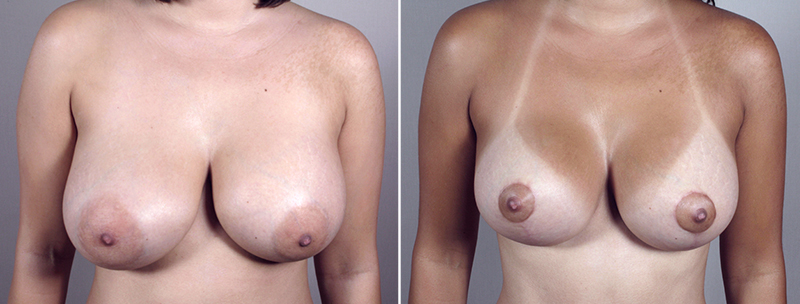
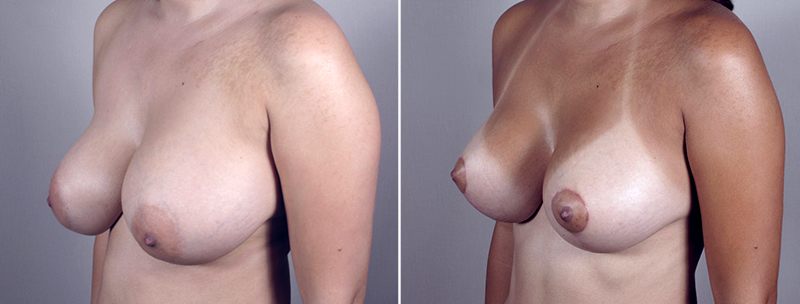
29 year old who had 400 cc saline implants inserted by another plastic surgeon previously. She felt they were too large and heavy and caused her breasts to sag. Dr. Parker replaced these implants with 325 cc silicone implants and performed a vertical mastopexy, or “lollipop lift,” giving the patient a more youthful look.
Correction of Capsular Contracture
Breast implants, once inserted into the body, stimulate the formation of a lining around the implants that is referred to as a “breast capsule.” In a relatively small percentage of patients, the capsule hardens, often distorting the shape of the breast; this is called “capsular contracture.”
Traditionally, treatment has involved surgical removal of these capsules and implants, followed by replacement with new implants. Dr. Parker can also make other improvements at the same time: insertion of a different type or size of implant or different pocket location of the implant. Typically, Dr. Parker can use the same incision used to insert the original implants. This treatment by Dr. Parker is illustrated below.
Before & After: Capsular Contracture*
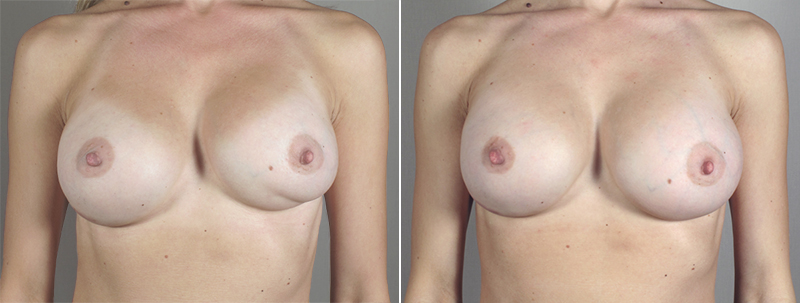
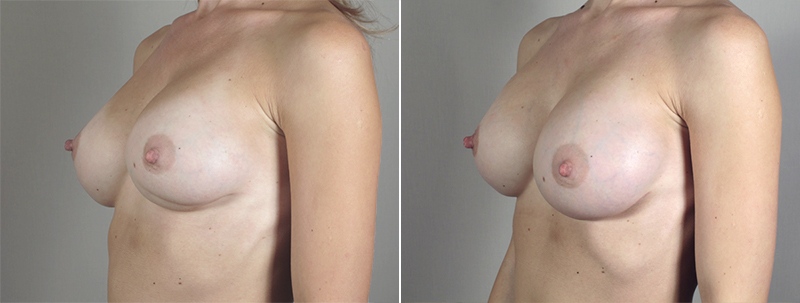
28 year old who developed left breast capsular contracture 2 years after the insertion of 375 cc silicone implants located in partial submuscular pockets. She underwent removal of her capsules and implants on both sides along with insertion of 475 cc silicone implants.
Non-Surgical Capsular Contracture Treatment Option
Today, Parker Center patients are offered non-surgical correction capsular contracture with the Aspen Ultrasound System. This modality has helped many of our patients resolve the pain, breast firmness, and distortion of their breast implants. Learn more >>
Treatment of Rippling & Palpability, More Common with Saline Implants
The edges of breast implants can be visible and palpable (able to be seen and felt). This is more likely in thin patients with little breast tissue who have saline implants placed in a subglandular location. This does not pose a health risk, but patients are often bothered by what they (or their partner) see and feel.
To treat this, Dr. Parker will typically insert silicone implants into a partial submuscular breast pocket, which are less palpable and demonstrate less rippling than saline implants. This is shown in the patient below.
Before & After: New Silicone Implants Placed Submuscularly*
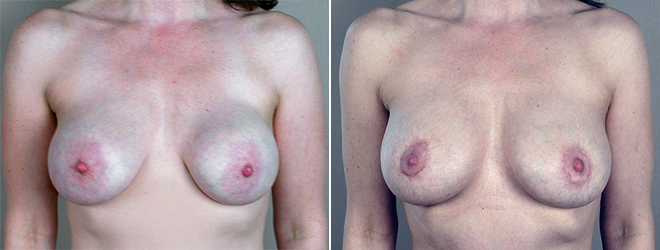
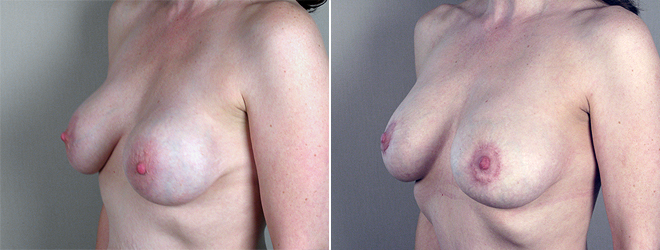
41 year old who complained of visible and palpable rippling after the insertion of subglandular saline implants by another plastic surgeon. Dr. Parker removed her saline implants, 360 and 390 cc from the right and left breasts respectively, then replaced them with 400 cc silicone implants in a partial submuscular location. He also reduced the size of the patient’s areolas, in accordance with her wishes.
Correction of Implant Deflation or Leakage
There is much confusion about how long breast implants will last. Some plastic surgeons recommend replacing breast implants after 10-15 years. Dr. Parker tells his patients that if their implants are soft, normal looking, and do not cause problems, then these implants do not need to be replaced.
If a saline filled implant leaks, it will be very apparent, as shown in the example below. The saline solution is quickly absorbed by the body and the “deflated” side immediately looks smaller than the intact side.
The gel inside silicone implants is inert and not absorbed by the body if the implant’s outer shell breaks. Thus the appearance and feel of a silicone gel implant typically does not change with rupture. Imaging tests such as ultrasound, mammogram or MRI are necessary to detect a rupture. While there is no evidence that the silicone gel in FDA approved implants is harmful in the event of a rupture, the FDA recommends periodic MRI scans to minimize the chance of undetected leakage. If leakage is found, it is recommended that the implant be replaced.
The latest generation of silicone implants, made of a cohesive type of silicone gel, are impressive with regard to their lower likelihood of leakage. Long term studies are in progress to quantify their leak rate compared to the older silicone implants.
Dr. Parker and his team will discuss these issues with you during your consultation. The patient below demonstrates the presentation and treatment of a leaking saline filled breast implant.
Before & After: Replacing a Ruptured Implant*
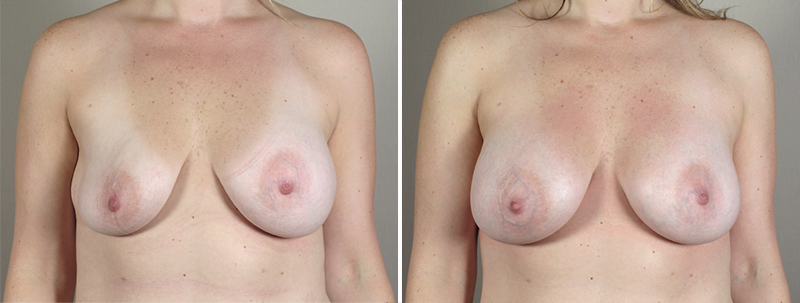
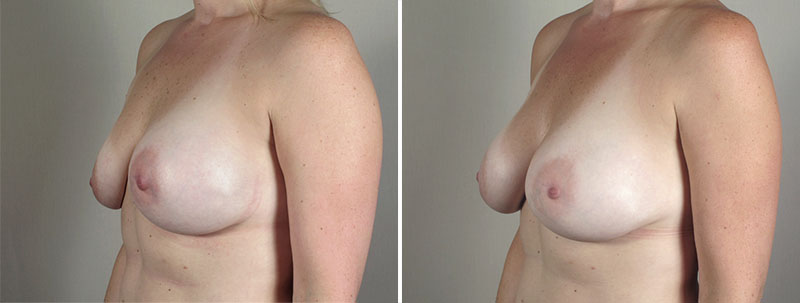
35 year old who presented to Dr. Parker with a recent spontaneous deflation of her right breast implant, 15 years after her initial surgery. The patient requested that Dr. Parker replace her existing 325 cc saline implants with 375 cc silicone implants.
Treatment of a “Double Bubble” Deformity (Inframammary Fold Asymmetry)
In performing breast augmentation, the surgeon creates a “pocket” to house the breast implant. This is performed above the crease at the lower aspect of the breast called the inframammary fold. If the dissection is carried too low and/ or the fold is weak, the implant can migrate downward below the fold, causing what is known as a “double bubble” appearance. This creates an asymmetry of the inframammary folds.
To treat a “double bubble” deformity, Dr. Parker will temporarily remove the implant through the same incision used to insert it, reconstruct the inframammary fold with several layers of sutures, and then reinsert the implant into its proper position. This is shown below.
Before & After: Correction of “Double Bubble” Deformity*
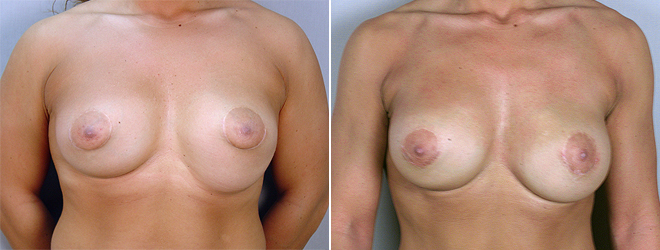
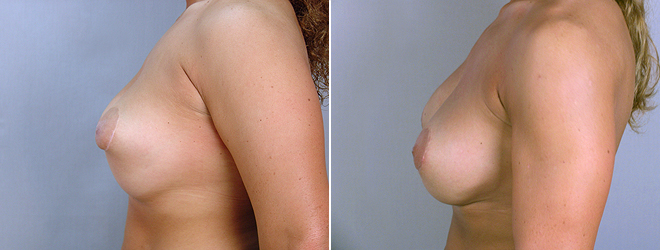
26 year old, after breast augmentation by another plastic surgeon, asked Dr. Parker to correct the loss of her inframammary fold and implant displacement downward. Using her existing peri areolar scars, Dr. Parker inserted internal sutures to reconstruct her inframammary fold and reposition the implant in a better location. As requested by the patient, he also reduced the size of her areolas.
Correction of Implant Malposition
Malpositioned implants result when one or both implants are too high, too low, too lateral (too far apart from one another) or too medial (too close to each other, called “symmastia”). Treatment involves surgical adjustment of the pockets, as appropriate. Often, using the same incision, Dr. Parker revises one or both implant pockets in order to properly reposition the implants in the desired location, as seen in the example below.
Before & After: Correcting Implant Malposition*
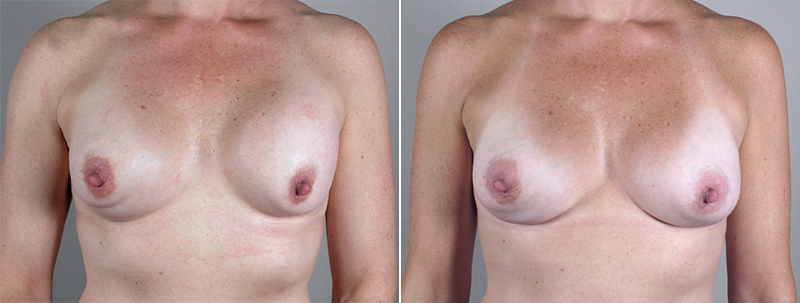
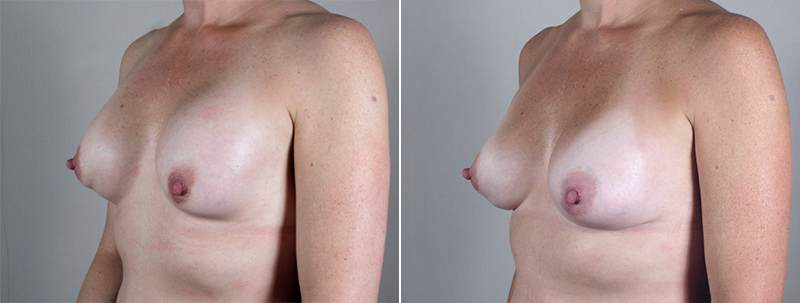
44 year old patient, 6 years after 330 cc saline breast augmentation by another plastic surgeon, complained to Dr. Parker that her implants were too far apart and “looked fake”. Using the patient’s healed inframammary incisions, Dr. Parker removed her existing implants and scar tissue. He corrected the malpositioned implants by dissecting the implant pockets more medially to allow cleavage, sutured the lateral aspect of the pockets to keep the implants in place, and inserted 300 cc silicone implants, as requested by the patient.
Prior Breast Augmentation with French PIP Breast Implants
Breast implants made by a French company called Poly Implant Prosthesis (PIP) were found to be defective in 2011. An investigation determined the company used industrial grade silicone, not medical grade silicone, as the gel in their implants. In addition, the company covered the gel with substandard implant shells, found considerably more likely to leak. It has been estimated that over 30,000 European women have discovered they have these defective implants. If a patient believes they have PIP implants in place, it is recommended they be removed.
Dr. Parker removes these implants through the original incision, and during the same operation inserts new implants. PIP implants were never approved by our FDA, so their use in this country was very uncommon. A patient with PIP implants is demonstrated below.
Before & After: Replacing PIP Implants*
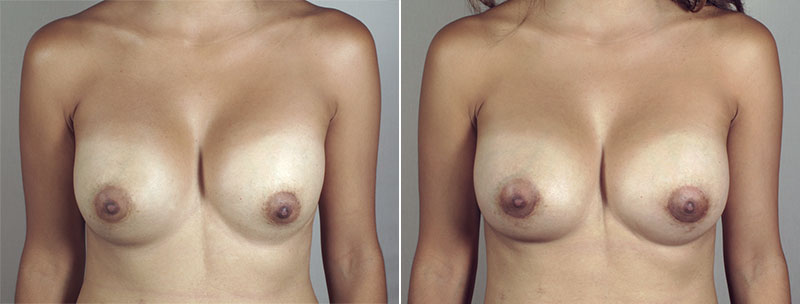
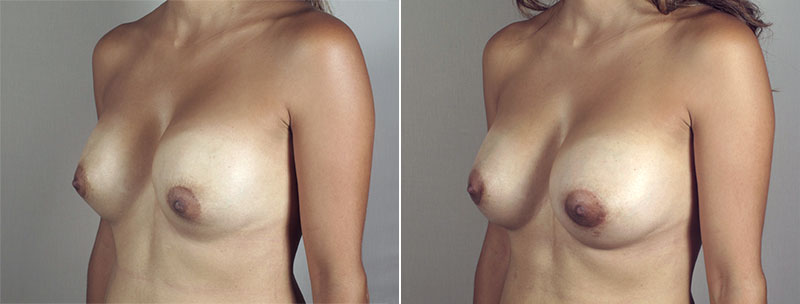
35 year old patient who had breast augmentation performed in South America 5 years ago. She recently heard about the controversy over French PIP implants and their likelihood of leakage. Though she was asymptomatic, the patient had an ultrasound and MRI of her breasts performed. These demonstrated leakage of her right breast implant. At surgery, Dr. Parker removed her 385 cc PIP implants through her healed peri areolar incisions. He found the right implant to be completely disintegrated. The left implant was intact. Dr. Parker replaced these implants with 475 cc silicone implants.
Breast Implant Removal
From time to time, a patient will decide they no longer wish to keep their breast implants, due to problems or a change in aesthetic preferences. Dr. Parker can remove implants using a procedure called “explantation.” Such a patient is shown below.
Before & After: Breast Implant Removal (Explantation)*
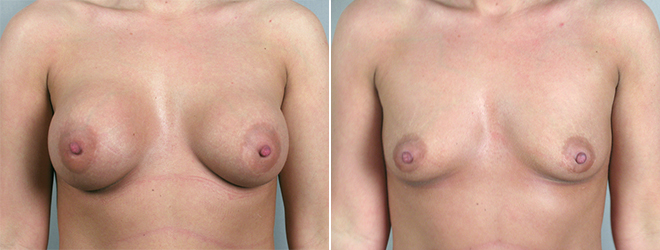
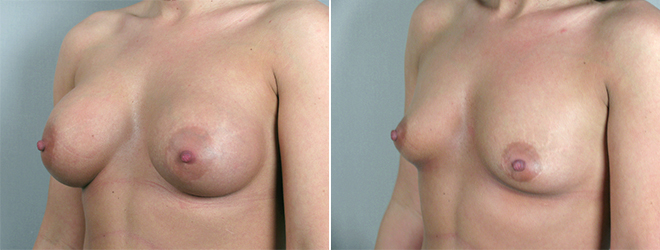
37 year old patient who requested implant removal, or “explantation,” by Dr. Parker.
During your consultation, New Jersey plastic surgeon Dr. Parker will discuss options involving implant removal with you. If your implants are large and your skin has stretched, a breast lift may be recommended as well. The original incision used to insert the implant is almost always the same one used to remove it. The lining around the implant, or “capsule,” is often removed at the same time to facilitate more rapid healing.

Leave a Reply